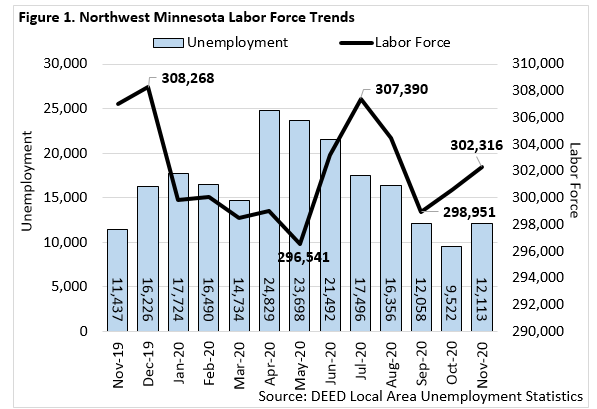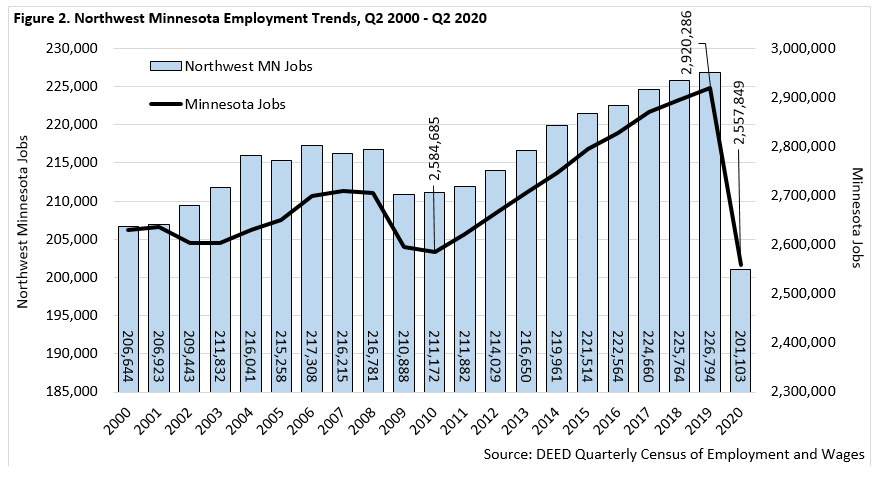by Tim O'Neill
October 2020
Northwest Minnesota's labor market has undergone enormous stress during 2020 from the COVID-19 pandemic. This stress has been felt across every industry sector and occupational group and among each of the region's 26 counties. This spotlight article presents an update1 on how COVID-19 has affected Northwest Minnesota's labor force and industry employment as well as show which occupations are still in demand.
One of the first datapoints that comes to mind during a recession is the unemployment rate. Because of COVID-19 and subsequent pandemic safety measures, the unemployment rate in Northwest Minnesota has witnessed extreme whiplash. Within the span of a year the region's unemployment rate went from 2.6% to 8.3% to 4.0%. At its height in April 2020, the number of unemployed persons equaled nearly 25,000. This was triple the 8,300 unemployed persons in the region just six months earlier. As of November 2020, approximately 12,100 people were unemployed in Northwest Minnesota (Figure 1).

Like unemployment, Northwest Minnesota's labor force also underwent whiplash during the past year. After reaching nearly 308,300 people in December 2019, the region's labor force declined by 3.8% through May 2020, which was equivalent to over 11,700 people. After rebounding through July 2020, the labor force slipped again through September, this time by over 8,400 people. The unemployment and labor force whiplash experienced in Northwest Minnesota over the past year masks a lot of complexities that workers in the region are facing. For example, some workers may have experienced temporary layoffs or reduced hours. Other people may have decided to leave their work for health and safety concerns or may have chosen to retire. Meanwhile, other workers may have been permanently let go and are looking to transition into a new occupation or are considering going back to school.
Not all counties in Northwest Minnesota have fared equally during COVID-19. During the height of unemployment in April, for example, such rates were especially high for Mahnomen County (17.3%), Clearwater County (13.9%), Cass County (13.3%), Wadena County (11.2%), Crow Wing County (11.1%), Lake of the Woods County (10.9%), Hubbard County (10.5%), and Pennington County (10.1%). As of November 2020, unemployment rates remain significantly higher for Mahnomen County, Clearwater County, Cass County, Morrison County, and Lake of the Woods County.
On top of labor force and unemployment swings, there is no denying that Northwest Minnesota's industry employment took a hit during 2020. Overall, between the second quarters of 2019 and 2020, employment in Northwest Minnesota dropped by 11.3% or nearly 25,700 jobs. To put this in perspective, the region had gained about 15,900 jobs in the past decade of employment expansion. Or put another way, the region lost over four times as many jobs in 2020 as it did during the Great Recession in 2008 and 2009 (Figure 2).

Like unemployment rates, total employment losses over the year were not equal among the 26 counties of Northwest Minnesota. Crow Wing County, the region's largest-employing county, lost the most jobs (-4,390 jobs) between the second quarters of 2019 and 2020. Those counties losing more than 2,000 jobs included Otter Tail County (-2,474 jobs), Douglas County (-2,311 jobs), Cass County (-2,052 jobs), and Clay County (-2,033 jobs). Those counties losing more than 1,000 jobs included Becker County (-1,984 jobs), Beltrami County (-1,836 jobs), Pennington County (-1,311 jobs), and Polk County (-1,021 jobs). Mahnomen County was especially hard hit, with its total employment dropping by 38.3% between the second quarters of 2019 and 2020. While still losing employment over the year, Todd County (-4.8%), Marshall County (-5.5%), Stevens County (-5.9%), and Kittson County (-6.4%) fared a bit better than their Northwest Minnesota neighbors.
Zooming back out to the regional level, over one-third of Northwest Minnesota's employment loss was in Accommodation and Food Services, half of this being in Restaurants. Other major industry sectors losing significant employment between the second quarters of 2019 and 2020 included Educational Services, Manufacturing, Retail Trade, Health Care and Social Assistance, Other Services, and Arts, Entertainment, and Recreation. Altogether, these seven industry sectors accounted for 90.1% of Northwest Minnesota's employment loss in 2020 (Table 1).
While severe, Northwest Minnesota's total employment loss over the year, 11.3%, was less than the statewide employment loss during that period, 12.4%. Those industry sectors most severely affected by the pandemic, being Accommodation and Food Services, Health Care and Social Assistance, Other Services, Retail Trade, and Arts, Entertainment, and Recreation all fared a bit better in Northwest Minnesota than they did statewide. Those industries hit harder in Northwest Minnesota, however, included Management of Companies, Educational Services, Manufacturing, Information, Utilities, and Professional, Scientific, and Technical Services (Table 1).
Employment levels within Minnesota have rebounded some since the second quarter of 2020. According to the Department of Employment and Economic Development's (DEED) Current Employment Statistics (CES), the state gained back about half of the jobs it lost during the spring of 2020 through the month of October, before a slight loss of jobs in November. Upcoming releases of data from the Quarterly Census of Employment and Wages (QCEW) will reveal if employment levels have rebounded in similar ways in Northwest Minnesota.
| Table 1. Northwest Minnesota Industry Employment | ||||||
|---|---|---|---|---|---|---|
| Industry | Q2 2020 Data | Q2 2019 – Q2 2020 Job Change | ||||
| Number of Firms | Number of Jobs | Avg. Annual Wage | Numeric | Percent | MN Percent | |
| Total, All Industries | 17,558 | 201,103 | $44,460 | -25,691 | -11.3% | -12.4% |
| Health Care and Social Assistance | 1,767 | 36,931 | $46,748 | -2,291 | -5.8% | -7.3% |
| Manufacturing | 843 | 26,879 | $50,076 | -2,809 | -9.5% | -6.8% |
| Retail Trade | 2,347 | 25,819 | $29,744 | -2,362 | -8.4% | -13.6% |
| Educational Services | 380 | 20,700 | $51,116 | -3,021 | -12.7% | -8.7% |
| Public Administration | 725 | 15,899 | $50,804 | -702 | -4.2% | -5.8% |
| Accommodation and Food Services | 1,552 | 14,025 | $17,264 | -9,007 | -39.1% | -43.9% |
| Construction | 2,340 | 11,901 | $54,860 | +67 | +0.6% | -4.8% |
| Wholesale Trade | 633 | 10,905 | $54,808 | -457 | -4.0% | -4.9% |
| Finance and Insurance | 878 | 5,862 | $58,448 | -61 | -1.0% | -1.3% |
| Transportation and Warehousing | 902 | 5,716 | $44,980 | -276 | -4.6% | -7.6% |
| Agriculture | 881 | 5,232 | $42,744 | +42 | +0.8% | +0.7% |
| Other Services | 1,501 | 4,823 | $27,872 | -2,006 | -29.4% | -33.0% |
| Professional, Scientific, and Technical Services | 869 | 4,564 | $53,768 | -250 | -5.2% | -4.7% |
| Administrative and Support Services | 676 | 3,762 | $35,100 | -461 | -10.9% | -19.0% |
| Information | 242 | 2,289 | $51,896 | -305 | -11.8% | -10.5% |
| Arts, Entertainment, and Recreation | 397 | 2,169 | $20,956 | -1,657 | -43.3% | -52.6% |
| Real Estate and Rental and Leasing | 460 | 1,464 | $36,452 | -49 | -3.2% | -7.9% |
| Utilities | 69 | 1,263 | $88,036 | -29 | -2.2% | -1.8% |
| Management of Companies | 54 | 641 | $95,004 | -71 | -10.0% | -5.4% |
| Mining | 42 | 254 | $59,228 | +16 | +6.7% | -12.8% |
| Source: DEED Quarterly Census of Employment and Wages (QCEW) | ||||||
Despite a roller-coaster of labor force and industry trends during 2020, there are still occupations in demand in Northwest Minnesota. According to DEED's Job Vacancy Survey (JVS), Northwest Minnesota employers reported 12,180 job vacancies during the second quarter of 2020. This represented only a slight (6.5%) drop from one year previous, when employers reported 13,020 job vacancies during the second quarter of 2019. By occupational group, most vacancies were within Sales and Related Occupations, Building and Grounds Cleaning and Maintenance Occupations, Food Preparation and Serving Related Occupations, Healthcare Support Occupations, Transportation and Material Moving Occupations, and Healthcare Practitioners and Technical Occupations. Of 22 major occupational groups, these six groups accounted for nearly two-thirds of Northwest Minnesota's total job vacancies in 2020.
According to DEED's Occupations in Demand tool, which combines job vacancy data with Unemployment Insurance (UI) Statistics and Occupational Employment Statistics (OES), Registered Nurses is the most in-demand occupation in Northwest Minnesota. Many of those occupations in demand for the region are within those occupational groups that had the most job vacancies during the second quarter of 2020, such as Healthcare Support, Healthcare Practitioners and Technical Occupations, and Transportation and Material Moving (Table 2).
| Table 2. Northwest Minnesota Top 20 Occupations in Demand, 2020 | ||||
|---|---|---|---|---|
| SOC Code | Job Title | 25th Percentile Wage | Median Wage | Education Requirements |
| 291141 | Registered Nurses | $60,187 | $70,869 | Associate degree |
| 372012 | Maids and Housekeeping Cleaners | $25,192 | $29,059 | High school diploma or equivalent |
| 311120 | Home Health and Personal Care Aides | $24,362 | $27,537 | High school diploma or equivalent |
| 311131 | Nursing Assistants | $29,424 | $33,192 | Postsecondary non-degree award |
| 537062 | Laborers and Freight, Stock, and Material Movers | $27,977 | $33,677 | High school diploma or equivalent |
| 259045 | Teaching Assistants, Except Postsecondary | $27,132 | $31,147 | High school diploma or equivalent |
| 533032 | Heavy and Tractor-Trailer Truck Drivers | $38,520 | $45,816 | High school diploma or equivalent |
| 292052 | Pharmacy Technicians | $28,937 | $35,018 | High school diploma or equivalent |
| 292061 | Licensed Practical and Licensed Vocational Nurses | $40,066 | $44,853 | Postsecondary non-degree award |
| 252021 | Elementary School Teachers | $45,108 | $55,653 | Bachelor's degree |
| 434111 | Interviewers, Except Eligibility and Loan | $28,825 | $32,542 | High school diploma or equivalent |
| 372011 | Janitors and Cleaners | $25,733 | $30,581 | High school diploma or equivalent |
| 252031 | Secondary School Teachers | $48,615 | $57,557 | Bachelor's degree |
| 512090 | Miscellaneous Assemblers and Fabricators | $33,104 | $38,150 | High school diploma or equivalent |
| 253031 | Substitute Teachers, Short-Term | $31,963 | $36,299 | Bachelor's degree |
| 472073 | Construction Equipment Operators | $42,787 | $50,500 | High school diploma or equivalent |
| 537065 | Stockers and Order Fillers | $24,565 | $28,049 | High school diploma or equivalent |
| 434051 | Customer Service Representatives | $28,709 | $36,011 | High school diploma or equivalent |
| 292056 | Veterinary Technologists and Technicians | $32,501 | $35,815 | Associate degree |
| 472061 | Construction Laborers | $28,856 | $34,617 | High school diploma or equivalent |
| Source: DEED Occupations in Demand | ||||
Monitoring the industries and people impacted by the economic stress of COVID-19 will continue to be important from a recovery standpoint. While unemployment is down in recent months, there are still thousands of people looking for work. While Northwest Minnesota fared the initial shock of COVID-19 better than the state, 17 of 20 major industry sectors witnessed losses over the year, impacting virtually all businesses. While there are job openings available, efforts should continue to be made to connect jobseekers with employers who are hiring.
1White, Erik. "An Introduction to the Region and the Impacts of COVID-19." Minnesota Employment Review, Minnesota Department of Employment and Economic Development, May 2020.